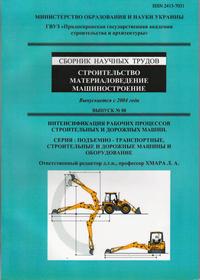Equipment for preparatory works at implementation of trenches
Keywords:
There are trenches, strong soils, rippers, indents rakish.Abstract
Summary. Raising of problem. One of types of production of earthworks there is implementation of trenches under various engineering’s buildings and technological communications. In military business there is a considerable necessity for similar works at implementation of trenches for shelter of personnel and trenches for the location of technique. In the case of production of works in winter, soils have considerably higher indexes of mechanical properties in comparing to other periods of year. For development of the frozen and strong s oils utilize bulldozers-rippers which execute preparatory works from loosening of such soils before work of basic earthmovers (power -shovels). After the requirements of production of trenches for military operations them lateral surfaces need to be execute d speak or with small inclination, that existent bulldozers-rippers do not execute. Purpose. Development of suggestions from the improvement of rippers for the increase of efficiency of preparatory works at implementation of trenches . Conclusion. Implementation of trenches in the frozen and strong soils is related to the necessity of their development rippers indents of which establishment rakish. The use of rippers with indents rakish provides implementation of trenches with vertical surfaces and promotes the productivity in 8,5.9,0 times in comparing to rippers of traditional construction.
References
Garbuzov Z.E. and Doskoij V.M. Ekskavatori neprerivnogo deijstvya [Power-shovels of continuous action]. Moscow: Higher school, 1987, 288 p. (in Russian).
Zakharchuk B.Z., Telushkin V.D, Shloydo G.A. and Yarkin A.A. Buldozeri i richliteli [Bulldozers and rippers]. Moscow: Mashynostroenye Publ, 1987, 240 p. (in Russian).
Kalibernov E.S. Spravochnik oficera inginernich voiysk [Reference book officer of engineerings troops]. Moscow: Military Publ, 1987, 288 p. (in Russian).
Kuznecova V.N. and Martyukov R.A. Eksperimentalni isledovaniya nagrugtniya zuba richlitelya pri razrabotke merzlich gruntov [Eksperimental researches of ladening of tooth of rippers at development of the frozen soils]. Stroitelni i dorogni mashini [Build and travelling machines]. 2006, no. 4, pp. 35-37. (in Russian).
Khmara L. A., Kravets S.V. and Skobluk N.P. Mashini dlya zemlyanich rabot [Machines are for earthworks: textbook]. Kharkov: KhNARU, 2014, 548 p. (in Ukrainian).
Khmara L.A., Shatov S.V., Glavackiy К.St., Lazdon V.C. [Hanging equipment of ripper]. Patent UA, no. 5275, 1994.
SP 104-34-96. Svod pravil po sooruzheniu magistralnich gazoprovodov. Proizvodstvo zemlyanich rabot [A vault governed on building of main gas pipelines. Production of earthworks]. Moscow: Minstroy Russian Federation, 1996, 28 p. (in Russian).
Rastegaev I.K. Mashini dlya vehnomerzlich gruntov [Machines for amictic soils]. Moscow: Mashynostroenye Publ, 1986, 216 p. (in Russian).
Rukovodstvo po voiyskovim fortikatsionim sooruzhenijam [Guidance on military fortification buildings]. Moscow: Military Publ, 1989, 112 p. (in Russian).
Glazkov A.A., Manakov N.A. and Pankratov A.V. Stroitelnaya, dorognaya i spetsialnaya technika oteshestvenogo proizvodstva. Kratkiiy spravochnik [Build, travelling and special technique of domestic production. Short reference book ]. Moskow: Business-Arsenal, 2000, 816 p. (in Russian).
Techniko-ekspluatastioni charakteristiki mashin firmi Caterpillar. Spravochnik [Tekhniko and operating description of machines of firm «Caterpillar». Reference book]. Caterpillar Inc., 1999, 724 p. (in USA).
Livinskiy O.M., Dorofeev V.S. and Ushackiy S.A. Technologia budivelnogo budivnistva. Kniga 1: zagalni vidomosti pro budivnistvo, roboti pidgotovshogo periodu, zemlyani raboti [Technology of a build production (Vol. 1: general information about building, robots of setup time, earthen robots): train aid ]. Kyiv: UAN, MP Lesya, 2012, 416 p. (in Ukrainian).
Khmara L.A. and Shatov S.V. Richlitel s posledovatelnim raspologeniem zubev [Rippers with the successive location of tooths]. Stroitelni i dorogni mashini [Build and travelling machines]. 1989, no. 2, pp. 104 -107. (in Russian).
Khmara L.A. and Shatov S.V. Ekspluatastioni ispitaniya richlitelya s robochim organom stupenchatogo tipa [Operating tests of ripper with the working organ of step type]. Stroitelstvo i architektura [Building and architecture]. 1987, no. 6, pp. 11-13. (in Russian).
Downloads
Published
Issue
Section
License
Редакція Видання категорично засуджує прояви плагіату в статтях та вживає всіх можливих заходів для його недопущення. Плагіат розглядається як форма порушення авторських прав і наукової етики.
При виявлені у статті більш ніж 25% запозиченого тексту без відповідних посилань та використання лапок, стаття кваліфікується як така, що містить плагіат. У цьому випадку стаття більше не розглядається редакцією, а автор отримує перше попередження.
Автори, в статтях яких повторно виявлено плагіат, не зможуть публікуватися в усіх журналах Видавництва ДВНЗ «Придніпровська державна академія будівництва та архітектури».
Автори, які публікуються у цьому журналі, погоджуються з наступними умовами:
- Автори залишають за собою право на авторство своєї роботи та передають журналу право першої публікації цієї роботи на умовах ліцензії Creative Commons Attribution License, котра дозволяє іншим особам вільно розповсюджувати опубліковану роботу з обов'язковим посиланням на авторів оригінальної роботи та першу публікацію роботи у цьому журналі.
- Автори мають право укладати самостійні додаткові угоди щодо неексклюзивного розповсюдження роботи у тому вигляді, в якому вона була опублікована цим журналом (наприклад, розміщувати роботу в електронному сховищі установи або публікувати у складі монографії), за умови збереження посилання на першу публікацію роботи у цьому журналі.
- Політика журналу дозволяє і заохочує розміщення авторами в мережі Інтернет (наприклад, у сховищах установ або на особистих веб-сайтах) рукопису роботи, як до подання цього рукопису до редакції, так і під час його редакційного опрацювання, оскільки це сприяє виникненню продуктивної наукової дискусії та позитивно позначається на оперативності та динаміці цитування опублікованої роботи (див. The Effect of Open Access).

